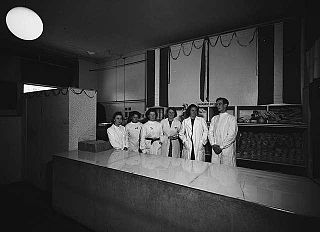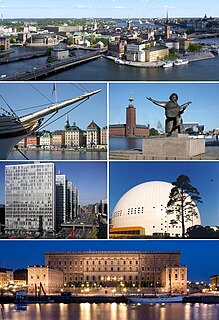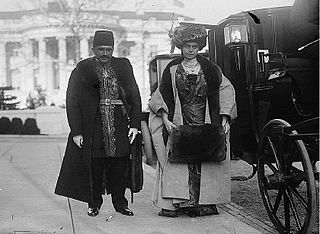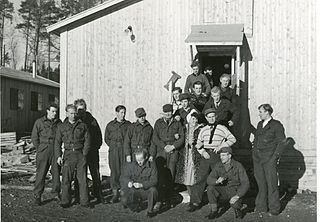
Tormod Kristoffer Hustad was the minister of agriculture in the 1940 pro-Nazi puppet government of Vidkun Quisling, provisional councilor of state for agriculture in the government appointed by Reichskommissar Josef Terboven in 1940, and minister of labour in the NS government 1942-1944. He was replaced by Hans Skarphagen in 1944. In the post-war legal purges he was convicted of treason and sentenced to life imprisonment and forced labour.
Atle Thowsen is a historian and the Director of the Bergen Maritime Museum and served as president of the International Commission for Maritime History from 2000 to 2005.

The Quisling regime or Quisling government are common names used to refer to the fascist collaborationist government led by Vidkun Quisling in German-occupied Norway during the Second World War. The official name of the regime from 1 February 1942 until its dissolution in May 1945 was Nasjonale regjering. Actual executive power was retained by the Reichskommissariat Norwegen, headed by Josef Terboven.
Jan Birger Jansen was a Norwegian physician, anatomist and scientist, specializing in brain research. He played an important role in the Norwegian civil resistance during the Second World War.
Norsk krigsleksikon 1940–1945 is a Norwegian encyclopaedia covering the Second World War.
Sverre Arnljot Breste Kjeldstadli was a Norwegian historian.

Danish humanitarian aid to Norway during World War II, in Norway called Norwegian: Danskehjelpen and in Denmark called Danish: Norgeshjælpen, resulted in 32,000 tons of food supplies from occupied Denmark to occupied Norway. The aid was initiated in 1941, after the formation of Den norske damekomité in Copenhagen. Among the central organizers in Denmark were Carl and Borghild Hammerich.
Swedish humanitarian aid to Norway during World War II, in Norway called Norwegian: Svenskehjelpen and in Sweden called Swedish: Svenska Norgehjälpen, amounted to around SEK 71 million. High priority was extra food for schoolchildren in Norway. In 1944 more than 100,000 portions of soup were administered daily from almost 1,000 distribution centrals.
The milk strike was a strike in Nazi-occupied Oslo on 8 and 9 September 1941. It led to strong reprisals from the German occupiers, in the form of martial law, court-martial, mass arrests, two executions and several long-term jail sentences.
Odd Fossum was a Norwegian shop assistant, and leader of the Norwegian Confederation of Trade Unions from 1941 to 1945, under the Nazi regime during the occupation of Norway by Nazi Germany. He was also the leader of NS Faggruppeorganisasjon from 12 October 1940 to September 1944, when he was succeeded by Olav M. Hoff.

Eric Welsh was a British chemist and naval intelligence officer during the Second World War. Between 1919 and 1940 he worked for the Bergen branch of the company International Paint Ltd. From 1941 he headed the Norwegian branch of Secret Intelligence Service (SIS). Welsh is fleetingly referred to in the Norwegian television series The Heavy Water War and, based on the comments by Stephen Dorril of Welsh as a "...ladies' man who drank and smoked to excess" and a "master of dirty tricks" alluded to as one of the models to James Bond
Werner Knab (1908–1943) was a German SS-Sturmbannführer. He served at the German legation in Norway from 1939, and then as head of Gestapo in Norway from 1940 to 1942, during the occupation of Norway by Nazi Germany. Among others, he led a crackdown on the University of Oslo following the milk strike, and also acted as prosecutor in the court-martial set up in the strike's wake. He died in Germany.
Hans Latza (1908–1975) was a German SS-Obersturmbannführer. He served as SS-judge in Munich from 1939 to 1940, in Prague in 1940, and in Oslo from 1940 to 1945. Latza was the principal judge at SS- und Polizeigerat in Norway. He was responsible for more than 25 death sentences. In the legal purge in Norway after World War II Latze and two co-judges were prosecuted for war crimes for their role when five persons had been sentenced to death in a court-martial reprisal following the assassination of police chief Karl Marthinsen, but Latza was acquitted by the Supreme Court in 1948.
Alfred Zeidler was a German shipbroker and later SS-Hauptsturmführer. He was born in Gdańsk. He served as Lagerkommandant of the Grini concentration camp in Bærum, Norway, from 1942 to 1945. In the legal purge in Norway after World War II, Zeidler was sentenced to life sentence in 1947, for crimes committed at Grini.
Egil Lindberg was a Norwegian radio officer and Secret Intelligence Service agent during World War II.
Norges-Nytt was a Norwegian magazine issued in Stockholm from September 1941 by the Press Office of the Norwegian legation in Stockholm. It had a circulation of up to 40,000 copies.
Andreas Kielland Rygg was a Norwegian military officer.














